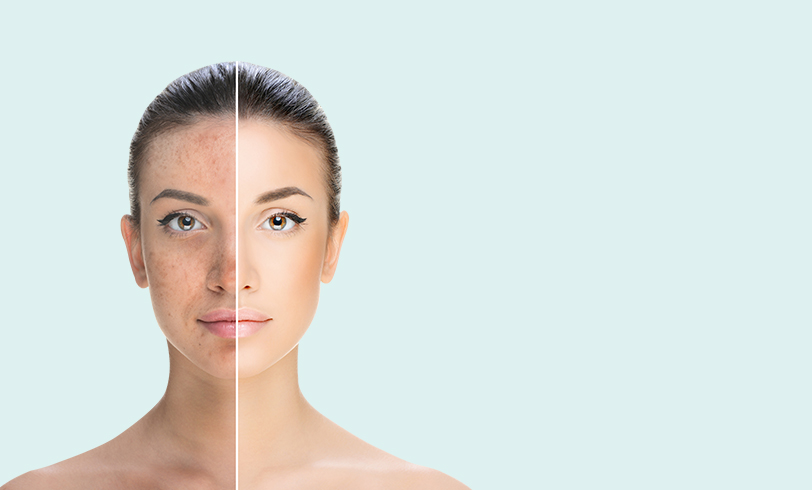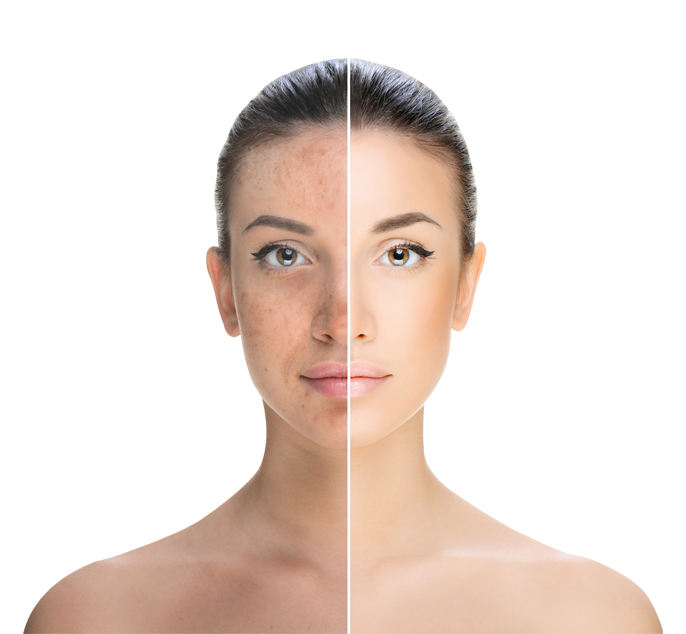

Skin Pigmentation
Causes, Symptoms And SolutionsHyperpigmentation, more commonly known as pigmentation, occurs when certain areas of the skin become darker due to excess melanin production. Melanin is the pigment that gives skin its colour. This common skin condition is often genetic and can further aggravate due to prolonged, excessive sun exposure and hormonal fluctuations. Certain medications, illnesses, and injuries can also result in uneven skin tone, dark spots and patchy complexion.
At Oliva Clinic, our dermatologists offer customised, proven and safe solutions to help you achieve an even-toned, glowing complexion.
What is Pigmentation?
The normal colouring of the skin, hair, mucous membranes, and the retina of the eye is due to the deposition of the pigment, melanin, which is produced by specialized cells called melanocytes. Whenever there is an excess production of melanin (hyperpigmentation), it causes dark spots, patches or the discolouration of the skin. This eventually affects the colour of our skin leading to uneven skin tone.
Hyperpigmentation usually affects patches of the skin making our skin appear darker than usual in some areas. They may vary in size or appear anywhere on the body. Therefore, a dermatologist will be the right person to determine the exact cause behind pigmentation.
Causes of Skin Pigmentation
Increased production of melanin due to certain internal or external factors can lead to the disorders of skin pigmentation.
-
Sun exposure
Pigmentation can be caused by sun exposure, specifically by its UVA rays, which penetrate deep into the skin and can cause excessive melanin production.
-
Injury
An external injury such as a cut, bruise or even pimples, improper hair removal, or depilatory creams can trigger an inflammatory reaction to the injury, leading to the production of extra melanin.
-
Medication
Certain medication can result in unwanted pigmentation as a side effect and is commonly seen with chemotherapy, tetracycline antibiotics etc.
-
Allergies
Contact dermatitis to cosmetics, hair dyes, etc. can cause pigmentation.
-
Hormonal fluctuations
Pigmentation occurs as a result of a hormonal imbalance due to a rise in levels of estrogen and progesterone in the body. This type of pigmentation, known as Melasma, can be triggered by pregnancy or birth control pills.
-
Hereditary
Hereditary factors can play a major role in pigmentation of the skin. For instance, lentigines are a type of pigmentary condition associated with hereditary multisystemic syndromes.
-
Illness or disease
Certain medical conditions such as Addison’s disease and other endocrine diseases result in the disruption of the body’s hormonal levels, and this can increase melanin production.
Types Of Pigmentation
Freckles
Freckles are a common type of skin pigmentation occurring as a result of frequent exposure to sunlight. They appear as tiny circular spots on exposed areas, like the face etc., and they usually affect people with a lighter skin tone. Heredity factors also play a role in causing them.
Post-inflammatory pigmentation
This occurs as our skin’s response to an injury such as bruises, burns, friction or harsh chemical treatments. This can also occur post-acne breakouts resulting in reddish, brown, or black marks.
Melasma
Melasma is a type of facial pigmentation that affects the deeper layers of the skin. It occurs in women more commonly as irregular brown to grey patches on the cheeks, nose, jawline, etc.
Sunspots
Also referred to as solar lentigines, these are pigmentation spots with clearly defined edges. These spots form due to sun exposure and the extent of pigmentation depends on the exposure of melanin pigment to UV rays.
Diagnosis
An experienced dermatologist can diagnose accurately and recommend treatment options to treat the specific type of pigmentation.
Initial Diagnosis
The dermatologist starts with a visible examination of the pigmentation. For a more detailed assessment, the dermatologist will do a dermascan analysis or a biopsy. They will further review your medical and family history to identify contributing factors.
Skin Assessment
The dermatologist may also conduct additional skin exams to learn about the underlying causes of pigmentation. They will then identify the unique factors like sun exposure or hereditary tendencies.
Treatment Recommendation
The dermatologist may prescribe topical treatments for the specific type of pigmentation. In severe cases, they will suggest advanced treatments like chemical peels and laser toning.
Are you at Risk?
-
Pigmentation is slightly more common in Asians.
-
A common cause of pigmentation is prolonged sun exposure.
-
This aggravates further if they are genetically prone to pigmentation.
Apply sunscreen
Have a consistent skincare routine
Use sun protection
Treatment Options
Treatments Explained
Prognosis
- Pigmentation on the skin may not be a severe medical condition, but it can aggravate if not treated in a timely manner.
- Dark spots, acne marks, and sunspots may fade with topical treatments.
- Severe discolouration requires an advanced treatment procedure such as laser therapy.
- A dermatologist can determine the extent of pigmentation and suggest the most effective treatment plan for you.

